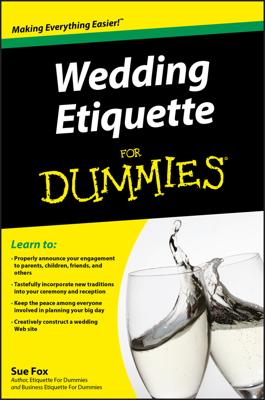A wedding invitation is meant to convey the necessary facts about your upcoming ceremony and the reception following. Order wedding invitations three to four months before the big day, and send them out no later than six weeks in advance. From its wording, form and addressing to its printing style and ink color, the wedding invitation is the subject of etiquette controversies, long chapters in wedding books and dictatorial outlines.
A traditional, formal wedding invitation is written in the third person, engraved on folded paper or heavy card stock in black ink, and mailed inside two envelopes, the inner envelope having no glue. Most are ecru, though some couples prefer pure white. The edges of invitations printed on card stock may be beveled with gold or silver.
Get the word out
The rules for the wording of formal invitations include the following:
Abbreviate and punctuate (almost) nothing. Spell out words like Doctor, Street, Road and Apartment and state names. The exceptions are Mr., Mrs., Ms. and Jr.
Use commas in only two spots: Between days and dates and between cities and states.
Omit the state if the city is well known
Employ British spellings of favour and honour.
Use "the honour of your presence" for ceremonies in a house of worship.
Use "the pleasure of your company" for ceremonies in a secular location.
Write out the numerals for long numbers in street addresses, unless they are particularly unwieldy.
Write out times including the word “o'clock.”
Use "half past" or "half after” in lieu of "-thirty" for half hours.
Write out years.
Always put the bride's name before the groom's.
Note that while Mr. is always used with the groom's name, the bride's name doesn't take Miss or Ms. In the case where the groom's parents are hosting the wedding, the rule is reversed.
Use military titles for brides and grooms on active duty. Fathers may use their military titles whether on active duty or retired.
Use professional titles (Doctor, Judge) for grooms and fathers.
Do not use professional titles for brides or mothers. The one exception for brides is if both mother and daughter are issuing the invitations.
Avoid invitation faux pas
While there are numerous ways to word your actual invitation depending on the parental situation and who's throwing the party, there are also a few things that are always in bad taste. Even those who want to turn down the formality should avoid these no-nos:
Cloying poetry and trite, drippy sentiments
Bad art
Tiny, messy things like confetti, glitter, and other things that can spill out of the envelope and scatter
Telling guests where you're registered and what you're hoping to receive
Noting that children aren't welcome
So many names as hosts that guests know without a doubt who's footing the bill
After ordering invitations, you receive a reader's proof of the text. Read this proof over very carefully; any mistakes you overlook aren't considered the printer's fault. Then have someone else — preferably someone who knows nothing about your wedding and thus doesn't have the same blind spots you do — proofread everything. Obvious typos are often the easiest to miss.

